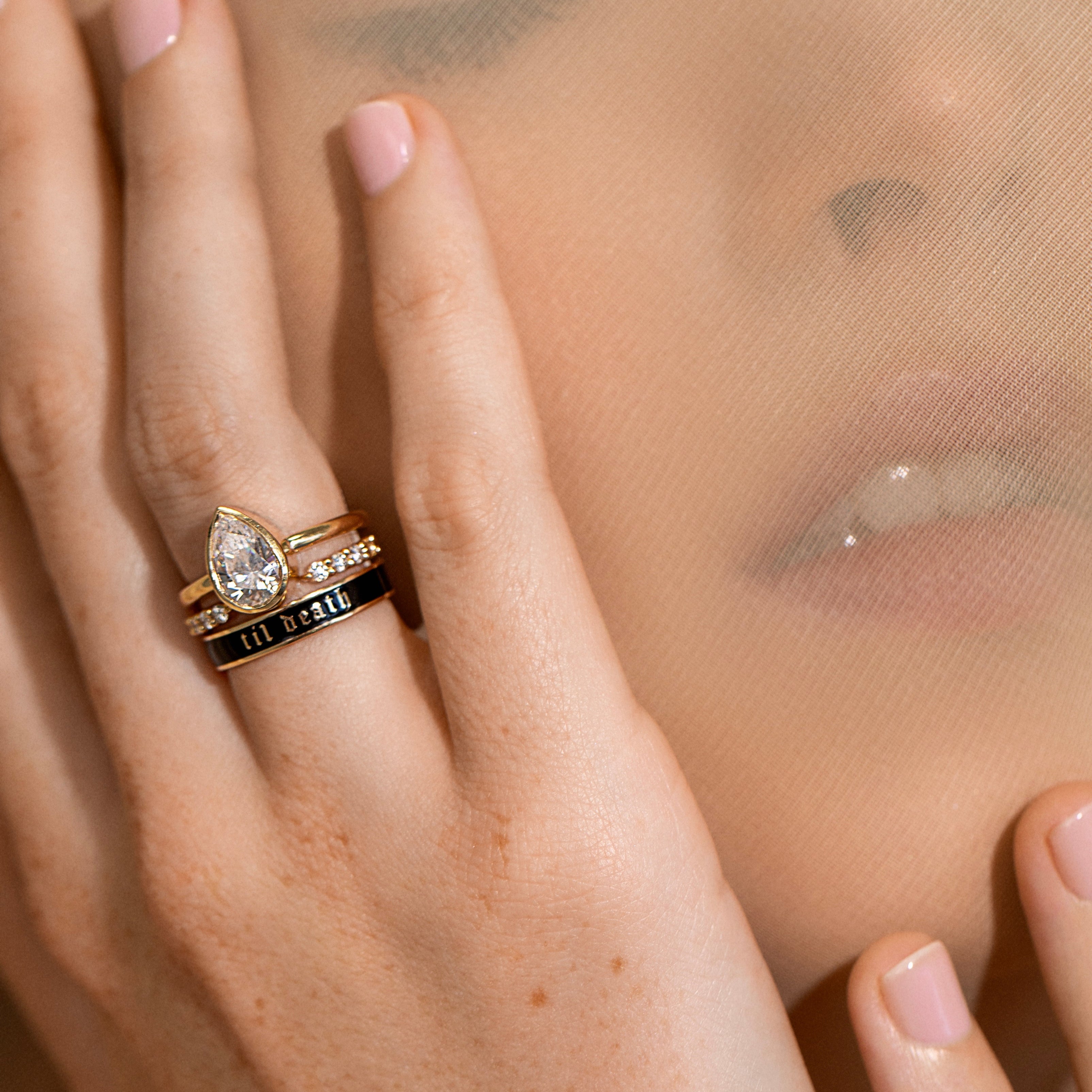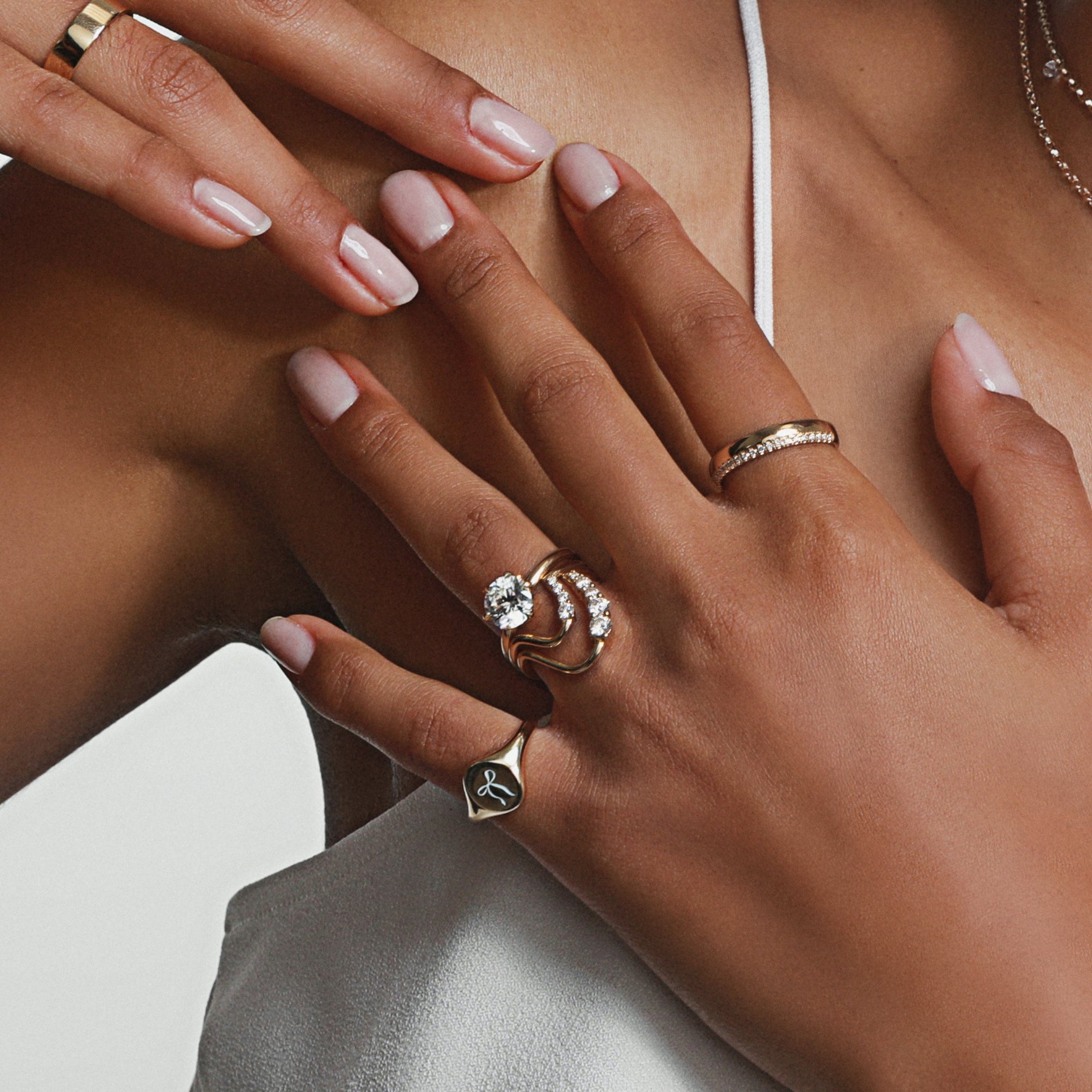Searching for the diamond of your dreams? Choosing a diamond can be a challenging and oftentimes intimidating task, but the process starts by understanding what makes each stone unique. Diamonds are graded based on the 4Cs – cut, color, clarity and carat – and these factors all impact the stone’s value and quality.
Whether you’re looking to invest in an engagement ring or introduce a new diamond piece to your collection, approaching the process with an understanding of the four C’s will support you in selecting *your* perfect diamond. Here’s everything you need to know:
What Is The Cut Of a Diamond?
Simply put, the cut of a diamond refers to the stone’s proportions and symmetry– and is the only factor not influenced by nature. This C determines how the diamond sparkles or interacts with light. A well-cut diamond (usually graded “Excellent” to “Very Good”) will reflect light best. Diamonds come in all different shapes and sizes, and can even be ordered in a custom cut. Remember, the dimensions and proportions of a stone can majorly influence the look of the diamond. Pro tip: choosing a diamond with a balanced length-to-width ratio can make your stone appear larger.
What Is The Most Expensive Diamond Cut?
The most expensive diamond cut is typically a round brilliant cut. Because of its precise facets and angles, a round brilliant cut maximizes the stone’s ability to reflect light, making it highly desirable. Plus, round diamonds require more of the original rough diamond to be cut away, leading to higher costs due to the loss of material.
What’s The Most Affordable Diamond Cut?
The most inexpensive cut of diamond is often the emerald cut (which features a rectangular shape with step-like facets and creates a unique “hall of mirror” effect rather than the traditional sparkle). It’s the least laborious diamond to cut, which influences its affordability, and also includes the highest percentage of the original rough diamond compared to the other cuts. However, the emerald cut’s large, open table can make inclusions and color more visible, so high-quality emerald cuts with excellent clarity and color can be more expensive.
How Are Diamond Cuts Graded?
Diamond cuts are graded based on several factors that determine the overall quality, brilliance and appearance of the diamond. The cut grade considers parameters like proportions, symmetry, polish, girdle thickness and culet size. Its grading is measured based on artisanship, with deductions given on the shape from the top, as well as if the diamond is cut too deep or too shallow.
The primary criteria are:
- Brilliance: the amount of light reflected from a diamond’s internal and external surfaces
- Fire: the dispersion of light into various colors of the spectrum
- Scintillation: the pattern of light and dark areas and the sparkle when the diamond is moved
The GIA uses the following cut grades:
- Excellent: Maximum brightness, fire, and scintillation
- Very Good: Slightly less bright but still impressive
- Good: Still bright but with noticeable differences
- Fair: Less brilliance and fire
- Poor: Lacks brilliance, fire and scintillation.
What Does The Color Of A Diamond Mean?
The color of a diamond is another important C to consider and can absolutely impact the diamond’s value and quality. The color grade is a measure of how much color is present and ranges from D (colorless) to Z (light yellow or brown). Colorless diamonds tend to fall at a higher price point as they are often highly sought after and less common than others. Here’s what the color of a diamond means:
Colorless (D-F):- D: Absolutely colorless. The highest color grade, which is extremely rare and valuable.
- E: Colorless. Only minute traces of color can be detected by an expert gemologist but still considered a very high-quality diamond
- F: Colorless. Slight color detected by a gemologist but still considered a “colorless” grade
- G-H: Near colorless. Color is almost imperceptible unless compared side-by-side with diamonds of better grades
- I-J: Near colorless. Slightly detectable color, but still offers excellent value
- K: Noticeable color, often a faint yellow
- L-M: Noticeable color, usually light yellow
- N-R: Very light yellow or brown tint. These diamonds have more noticeable color
- S-Z: Light yellow or brown. Color is easily noticeable to the naked aye
Diamonds can also come in a variety of colors, referred to as “fancy colors”. These include shades of blue, green, yellow, orange, red, pink, purple and black. Fancy color diamonds are graded differently and are often more valuable due to their rarity and unique appearance.
What Is Diamond Clarity?
Clarity refers to the presence of imperfections, known as inclusions (internal) and blemishes (external) - and this can affect the overall appearance and value of a diamond (higher clarity correlates with higher value). Location and type of inclusion are important to consider. For example, inclusions near the diamond’s edge may be less noticeable than those in the center.
How Is Diamond Clarity Measured?
This C is measured by evaluating both inclusions and blemishes using a standardized scale developed by the Gemological Institute of America (GIA). Here are the details:
- Flawless (FL): No inclusions or blemishes visible under 10x magnification.
- Internally Flawless (IF): No inclusions visible under 10x magnification, but may have some minor blemishes on the surface.
- Very Very Slightly Included (VVS1 and VVS2): Inclusions are extremely difficult to see under 10x magnification. VVS1 has fewer and smaller inclusions than VVS2.
- Very Slightly Included (VS1 and VS2): Inclusions are minor and range from difficult (VS1) to somewhat easy (VS2) to see under 10x magnification.
- Slightly Included (SI1 and SI2): Inclusions are noticeable under 10x magnification. SI1 has inclusions that are easier to see than those in SI2.
- Included (I1, I2, and I3): Inclusions are obvious under 10x magnification and may affect transparency and brilliance. I1 has fewer and less severe inclusions than I2, and I3 has the most inclusions.
What Is A Diamond Carat?
Last but not least, carat refers to the stone’s weight (not the size, contrary to popular belief!). The same carat weight diamond can appear larger or smaller, depending on its shape, cut and setting. For example, elongated shapes like ovals and marquise cuts can appear larger than they are. Poorly cut diamonds can also appear smaller than their carat weight. Usually, the larger the carat, the more expensive the diamond.
Ready to find the diamond of your dreams? Book a 1-on-1 appointment with our fine jewelry experts or browse a collection of one-of-a-kind diamond designs that are in stock and ready to ship.
![Til Death Black Enamel Band - 4mm [yellow gold front]](http://www.marrowfine.com/cdn/shop/files/Til_Death_Black_Enamel_Band_-_4mm.png?crop=center&height=1000&v=1727821921&width=1000)

![White Diamond Mini Lucy Wave Band [Yellow Gold]](http://www.marrowfine.com/cdn/shop/files/WhiteDiamondMiniLucyWaveBandYG.jpg?crop=center&height=1500&v=1741022376&width=1500)

![Something Blue Enamel Band [Yellow Gold]](http://www.marrowfine.com/cdn/shop/files/SomethingBlueEnamelBand.png?crop=center&height=1000&v=1727823884&width=1000)
![Something Blue Enamel Band [on hand]](http://www.marrowfine.com/cdn/shop/files/SomethingBlueEnamelBand_5.png?crop=center&height=1000&v=1740416231&width=1000)

![Marrow Fine Jewelry 6mm Til Death Black Enamel Band [Yellow Gold]](http://www.marrowfine.com/cdn/shop/files/Til_Death_Black_Enamel_Band_-_6mm.png?crop=center&height=240&v=1727823220&width=240)
![White Diamond Mini Lucy Wave Band [Yellow Gold]](http://www.marrowfine.com/cdn/shop/files/WhiteDiamondMiniLucyWaveBandYG.jpg?crop=center&height=240&v=1741022376&width=240)
![Everyday Wave Band - 3mm [Yellow Gold]](http://www.marrowfine.com/cdn/shop/files/LargeEverydayWaveBand_YG.jpg?crop=center&height=239&v=1719357278&width=240)
